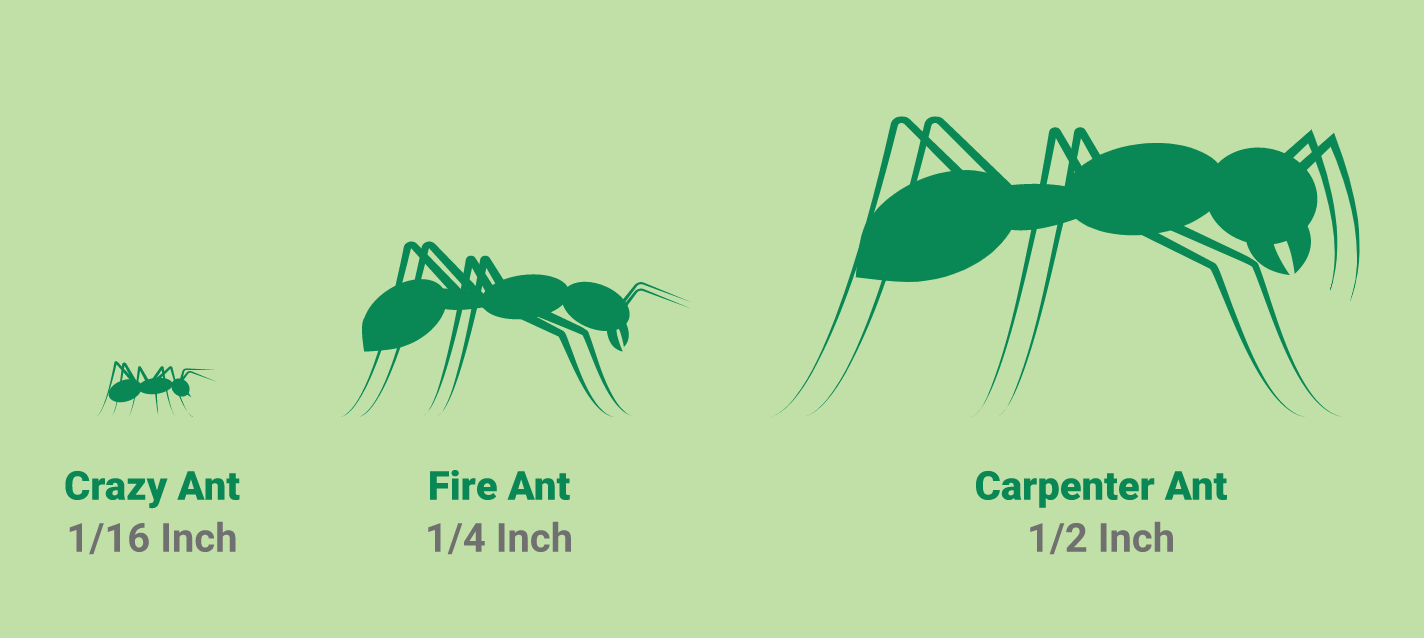Ant Identification
Ant identification typically involves examining various morphological characteristics of ants, which can vary greatly between species. Here are some key morphological features used for ant identification:
- Body Size and Shape: Ants vary in size from a fraction of a millimeter to several centimeters. Observing the overall size and shape of the ant can provide initial clues for identification. Some ants are slender and elongated, while others are more robust or have distinct body proportions.
- Body Segmentation: Ants, like all insects, have three main body segments: head, thorax, and abdomen. The relative size and shape of these segments, as well as any constrictions or joints between them, can aid in identification.
- Antennae: Antennae are important sensory organs for ants, used for detecting chemical cues, communicating with nestmates, and navigating their environment. The shape, length, and number of segments in the antennae can vary between ant species and are often used for identification.
- Head Features: The head of an ant may have distinctive features such as the presence of mandibles (jaws), the shape and size of the eyes, the presence of ocelli (simple eyes), and the configuration of the antennal sockets.
- Thorax Features: The thorax of an ant is where the legs and wings (if present) are attached. Observing the number and arrangement of spines, hairs, and other structures on the thorax can help distinguish between different ant species.
- Wing Venation (if present): In species with winged reproductives (queens and males), the venation pattern of the wings can be highly characteristic and useful for identification. Wing venation is typically examined under a microscope.

- Pilosity (Body Hair): The presence, distribution, and characteristics of hairs (pilosity) on the ant's body can be diagnostic. Some species have dense covering of hairs, while others may have sparse or absent pilosity.
- Coloration and Markings: The coloration and patterns on an ant's body, including any stripes, spots, or other markings, can be important for identification. However, coloration alone may not always be reliable, as it can vary within a species due to factors such as age, diet, and environmental conditions.
- Petiole and Postpetiole: Many ants have a distinct narrow waist, called the petiole, that separates the thorax from the abdomen. The shape and structure of the petiole and postpetiole (the segment following the petiole) can be important for identification.
- Genitalia (for males and queens): In some cases, examination of the genitalia may be necessary for accurate identification, especially for distinguishing between closely related species.
Distinctive Features
Ants, as a group of insects, exhibit these distinctive features:
- Social Structure: Ants are highly social insects, living in colonies that can range from a few individuals to millions. Each colony typically consists of one or more reproductive individuals (queens and males) and non-reproductive female workers.
- Division of Labor: Ant colonies have a well-defined division of labor, with different individuals performing specific tasks such as foraging, caring for the young (larvae), defending the colony, and reproduction.
- Communication: Ants communicate primarily through chemical signals known as pheromones. These chemical cues help them coordinate activities such as foraging, marking trails, and defending the colony.
- Eusociality: Ants exhibit eusocial behavior, which is characterized by cooperative brood care, overlapping generations, and division of labor. This level of social organization is seen in relatively few species and is one of the most advanced forms of social behavior in the animal kingdom.
- Antennae: Ants have distinctive antennae that are often elbowed or bent. These antennae are important for detecting chemical cues, sensing the environment, and communicating with other ants.
- Mandibles: Most ants have strong mandibles (jaws) that are used for various tasks such as excavating nests, carrying food, and defending the colony. The size and shape of mandibles can vary greatly between different ant species, reflecting their diverse ecological roles.
- Complex Nests: Ants construct complex nests underground, in trees, or within structures. These nests can include chambers for brood rearing, food storage, and waste disposal, as well as elaborate tunnel systems for navigation and ventilation.
- Ability to Farm Fungi and Raise Aphids: Certain species of ants engage in agriculture, cultivating fungi as a food source. Others "farm" aphids or other insects, protecting them from predators and "milking" them for honeydew.
- Strong Social Bonds: Ant colonies exhibit strong social bonds, with individuals cooperating for the collective benefit of the colony. This cooperation extends to tasks such as foraging, nest maintenance, and defense.
- Adaptability: Ants are highly adaptable and can be found in almost every terrestrial habitat on Earth, from deserts to rainforests to urban areas. They play crucial roles in ecosystem functioning, such as seed dispersal, soil aeration, and pest control.
These distinctive features contribute to the ecological success and diversity of ants, making them one of the most widespread and fascinating groups of insects.

Behavior:
- Ants are highly social insects, often living and foraging for food in colonies
- Worker ants often forage for food at night, between sunset and midnight
- Fire ants typically forage when air temperatures are between 70-to-90 degrees, making early evening and night the most popular times of day for activity
Habitat (Where to Treat)
- Ants typically nest underground in anthills or inside trees and build nests in cracks of pavement and within lawns outside
- Ants can be found inside the walls and voids of a building should they make it inside
- Fire ants most often build their nests in open areas such as lawn and pastures, and next to or under timber, logs, rocks or bricks.
Life Cycle
- Ants go through four stages of life cycle: egg, larva, pupa and adult
- Adult ants belong to one of three castes: queen, worker or male
Queen Production: Within the colony, worker ants tend to the care and feeding of certain larvae, which are destined to become future queens. These larvae are fed a special diet and receive particular care to promote their development into reproductive females.
Pupal Stage: The larvae undergo metamorphosis and develop into pupae. During this stage, they are still cared for by worker ants and continue to receive specialized care and nutrition.
Alate Formation: As the pupae mature, they develop into winged reproductive individuals, known as alates or "princesses". These alates have wings and are sexually mature females, ready to mate and establish new colonies.
Nuptial Flight: When environmental conditions are optimal, typically during warm, humid weather, fire ant colonies will initiate nuptial flights. During these flights, large numbers of alates from multiple colonies will take to the air simultaneously. The alates release pheromones to attract mates from other colonies.
Mating: During the nuptial flight, the alates mate with males from other colonies. After mating, the males typically die, while the mated queens land and seek out suitable locations for establishing new colonies.
Colony Foundation: Once the mated queens land, they shed their wings and begin searching for a suitable nesting site. Once a suitable location is found, the mated queen excavates a small chamber, lays her eggs, and begins rearing her first batch of worker ants. As the colony grows, the queen's primary role becomes laying eggs to replenish the colony's workforce.

- Eggs: Ant eggs are soft, oval and tiny and are laid by the queen
- Larva: The eggs hatch into worm-shaped larvae that depend on adults to provide a constant supply of food.
- Pupa: Larvae transform into pupae, which is the stage of rest and reorganization, as their legs and antennae are folded against their bodies.
- Adult: Pupae emerge as full-grown adults after several weeks or months, with young adults appearing lighter in color at first.
Damage/Risks
- Standard ants can cause allergic reactions to their bites and stings, are capable of contaminating food and can do serious structural property damage.
- Fire ant stings can cause a burning sensation, itching blisters, and even shock or death in severe cases
ZOËCON® PROFESSIONAL ANT CONTROL PRODUCTS
- Antack™ Liquid Ant Bait features the active ingredient Spinosad, an insecticide, in an attractive sweet liquid bait format which allows easy ingestion and better distribution throughout ant colonies.
- Formitrol® Ant Bait Gel combines two powerful active ingredients – our pioneering IGR, (S)-methoprene, and dinotefuran – creating a dual-action bait for lasting results. All ants belong to a single family, Formicidae – that’s why we chose the name Formitrol® .
ProBait® Formulation for Professionals
- ProBait® Formulation For Professionals fire ant bait provides relief by killing labeled ants immediately after ingestion.
Extinguish® Professional Fire Ant Bait & Extinguish® Plus
- Extinguish® Plus contains both the powerful adulticide Hydramethylnon to provide a quick knockdown of workers and foragers after ingestion and our pioneering IGR (S)-methoprene to affect the queen’s reproductive system.
- Extinguish® Professional Fire Ant Bait affects the fire ant queen’s reproductive abilities with our pioneering IGR, (S)-methoprene.
- ExciteR® contains a strong combination of pyrethrins and piperonyl butoxide (PBO). This insecticide synergist solution provides flushing power of flying and crawling insects alone or when mixed with most insecticides.
- ExciteR®55 features synergized pyrethrins to kill fleas, ants, ticks, and other labeled pests and the flip-up nozzle provides flexibility for indoor broadcast surface spraying and crack and crevice applications for hard-to-reach areas.
Achieve ConstANT Control
Whether you’re fighting carpenter ants or a red-hot fire ant population, Zoecon products are here to halt an infestation in its tracks, both indoors and out. Our product lineup comes in a variety formats, from liquids and gels to sprays and everything in between to ensure PMPs have the right solution in any battle against ants.

Ready to up the ante when it comes to ant control?
Contact a Zoecon sales rep to find the right solution for your needs.

















